3 Sequences
Descriptions of Three of the 113 Animation Sequences in Archive Fever
sequence # II
Websters & Francisco
12 minutes
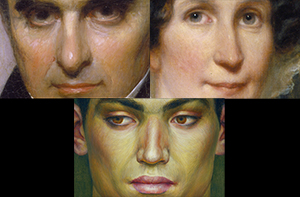
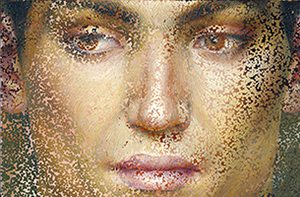
name: “portraitsMix01.dir”
audio clip: “piano 03”
Over a period of 12 minutes, three portraits by three American artists morph one to the next in this sequence, starting with a painting of Daniel Webster by Francis Alexander (Daniel Webster (Black Dan) [P.836.3]). Immediately, however, single pixels are “grabbed” from Chester Harding’s portrait of Mrs. Webster (Mrs. Daniel (Grace Fletcher) Webster [P.953.28]) and randomly begin to cover over the portrait of her husband. At about the time Mr. Webster’s image is no longer discernable and Mrs. Webster’s image is quite clear, pixels from another source, Paul Cadmus’ portrait of Francisco (Francisco [P.969.64.4]), begin merging with those of Mrs. Webster.
The uncanny transitions between the recognizable portraits of the three individuals provide subtly strange and unstable identities. Further, the degree to which each portrait morphs so easily, one might even say, naturally, into the next is slightly unnerving.
________________________________________________________________
sequence # IV
Claude Lorrain
9 minutes
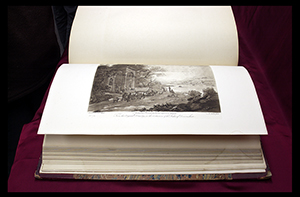
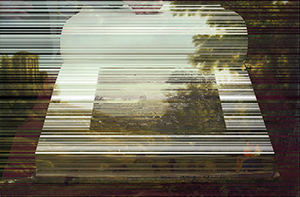
name: “claude2.dir”
audio clip: “pizzicato02”
This exquisite bound volume of Claude landscapes* contains 102 aquatints. MANUAL photographed every plate as the Assistant Registrar systematically turned each page. The opening minutes of the sequence presents this process slowly as the computer loads each image into memory. After the computer has gone through all frames it begins to animate the series at maximum speed in a continuous loop. Shortly thereafter horizontal lines “grabbed” from a separate, stored image of a Claude painting (Claude Lorrain, Landscape with a Shepherd and Shepherdess, c. 1636 [P.989.21]) randomly cover corresponding sections of the ongoing animation of page turning. Ultimately the image of the Claude painting completely replaces the animated loop, which persists in being “visible” until the very last line has been filled.
*Richard Earlom, British lithographer, 1743-1822 | After Claude Lorrain, French, 1604-1682, Liber Veritatis, or A Collection of Prints After the Original Designs of Claude Le Lorrain, Volume I [MIS.989.26A]
_______________________________________________________________
sequence # IX
Boli
2 minutes
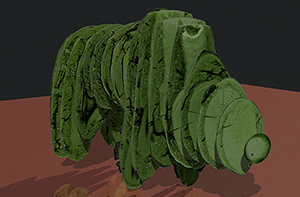
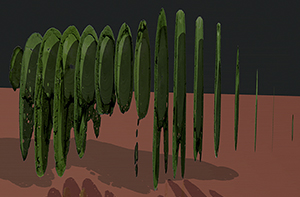
name: “Boli_anim.dir”
audio clip: “BoliMixes02/03”
Some objects revered by one culture cannot easily be explained to or through another. The Boli*, from the Bamana in Mali is such an object. It was not created as an art object, per se, but, rather, as an object imbued with mystical power, a ritualistic power-object made of earth, wood, animal and plant parts, pebbles and iron nails. Out of respect for its status as a highly sacred object to the Bambara peoples, the Boli is not physically exhibited by the Museum, but shown instead indirectly through various forms of representation. For one past exhibition, sets of MRI and X-ray films were made of the Boli at the Mary Hitchcock Memorial Hospital. These provided the source image-material MANUAL used to create 3D animated sequences.
The MRI process produced a series of cross-section scans of the Boli, front to rear. Using a digital camera, MANUAL photographed each large MRI Black and White negative, back lit on a light table, which gave them a green color cast, which MANUAL chose to keep and enhance. These image files were then used to reassemble — in strick registration — the whole form of the Boli and to animate it as a 3D object.
In this, one version out of the three contained in Archive Fever, the Boli revolves within a nondescript pink and gray environment, revealing both its massive and fragile nature as it turns.
*Power Object (Boli), 20th century, Africa | Mali | Bamana (Bambara) peoples [999.2.30363]